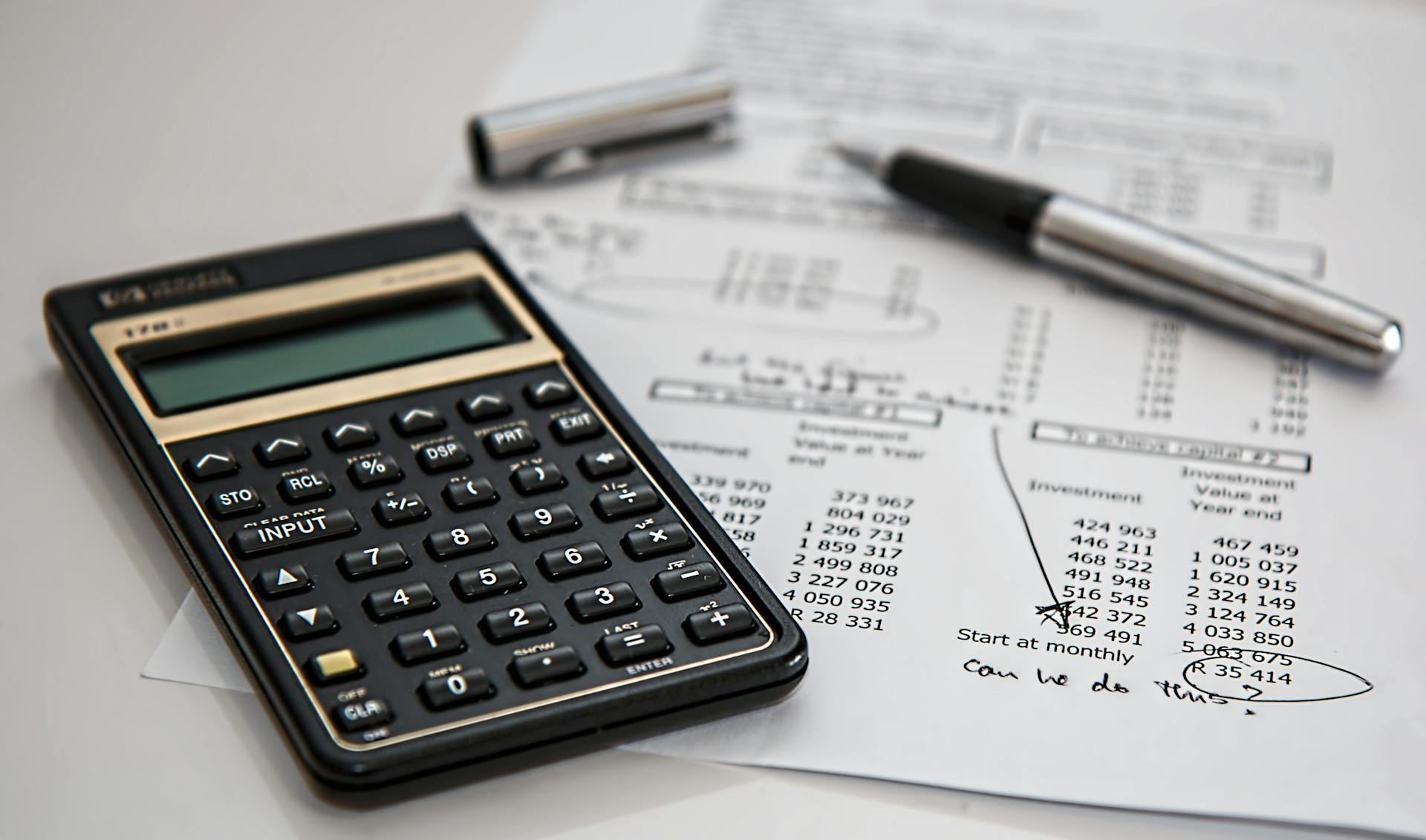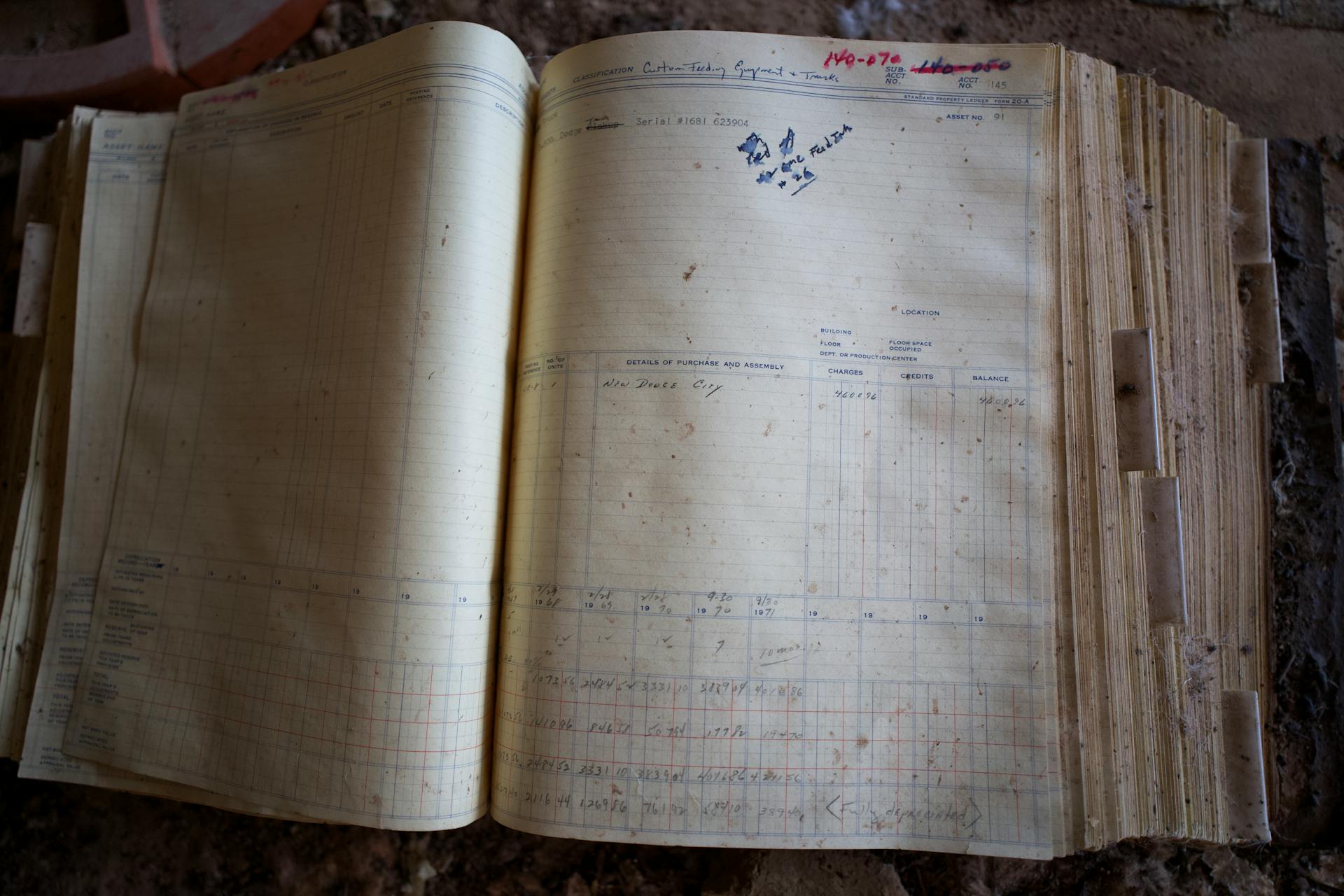
Depreciation is a key concept in accounting that helps businesses allocate the cost of assets over their useful life.
Accumulated depreciation is a contra-asset account that tracks the total depreciation expense over the asset's life.
You debit the asset account when it's first purchased, and then you credit the accumulated depreciation account as the asset loses value over time.
For example, if you purchase a piece of equipment for $10,000, you would debit the equipment account for $10,000 and credit the cash account for the same amount.
Definition
Accumulated depreciation is a decrease in the value of a tangible asset over its useful life. It's a key concept in accounting for assets like property, plant, and equipment.
Depreciation is the process of allocating the cost of an asset over its useful life, which can be 5-10 years or more. The cost of an asset is typically spread evenly over its useful life.
The asset's useful life is determined by its expected lifespan, which is often based on industry standards or manufacturer's guidelines. For example, a piece of equipment might have a useful life of 5 years.
Explore further: Is Straight Line Depreciation a Fixed Cost

Accumulated depreciation is the total decrease in an asset's value over its useful life. It's calculated by multiplying the asset's original cost by the percentage of its useful life that has passed.
To illustrate, if an asset costs $10,000 and has a useful life of 5 years, its annual depreciation would be 20% of its original cost.
Accounting for Depreciation
Accumulated depreciation is a contra-asset account that reduces the value of an asset over time. It's recorded on the balance sheet and is a key component of accounting for depreciation.
Accumulated depreciation is paired with Property, Plant and Equipment - Long-Term Fixed Assets, which is the parent account. This means that for every dollar of accumulated depreciation, there is a corresponding dollar of reduction in the value of the parent asset.
To illustrate this, consider the following example: if a company has a piece of equipment with a cost of $10,000 and an accumulated depreciation of $3,000, the net value of the equipment on the balance sheet would be $7,000.
A different take: Prepaid Expenses Appear in What Section of the Balance Sheet
Straight-Line Method

The straight-line method is a common way to calculate accumulated depreciation, and it's perfect for assets that depreciate at a steady rate, like buildings.
This method uses a simple formula: Annual accumulated depreciation = (asset value – salvage value) / useful life in years.
The asset value is the original cost of your asset, and the salvage value is its expected value once it’s no longer in usable condition.
For example, if you purchase a piece of equipment for $10,000, you can subtract the salvage value from the asset value to get the amount to be depreciated.
The useful life in years is the amount of time that you expect this asset to be usable for your needs, which is then divided by the amount to be depreciated.
If you expect to sell the parts for $1,000 after 10 years, the annual accumulated depreciation would be $900, which is calculated by dividing $9,000 by 10.
For your interest: Depreciated
Disposal

Disposal is a crucial step in accounting for depreciation. When an asset reaches the end of its useful life, the accumulated depreciation is reversed.
The journal entry for disposing of a fixed asset involves debiting the accumulated depreciation and crediting the fixed asset. This reverses the depreciation that had been recorded over time.
To illustrate this, let's consider the example from the journal entry table: Accumulated Depreciation is debited, and Fixed Asset is credited. This is a straightforward process that helps maintain the accuracy of your financial records.
Here's a summary of the journal entry for disposing of a fixed asset:
Debit or Credit?
Accumulated depreciation is a contra asset account that normally has a credit balance. It's credited when increased, which is the opposite of its parent Asset account that normally has a debit balance and is debited when increased.
The key to determining whether to debit or credit accumulated depreciation is to understand its relationship with its parent asset account. According to the accounting rules, a contra asset account like accumulated depreciation is credited when increased, which reduces the balance of the asset.
Here's a simple table to help you remember:
This table summarizes the debit and credit rules for accumulated depreciation and its parent asset account, making it easier to determine the correct entry.
Half-Year Recognition

When you buy an asset, you need to account for its depreciation over time. Half-year recognition is a method that helps with this, especially when an asset is purchased partway through the year.
In many cases, businesses will use the straight-line method to calculate the annual accumulated depreciation of the asset. This method is straightforward and easy to understand.
If an asset is only used for part of the year, you can't assign a full year of depreciation to the first year. Instead, you assign half of the annual depreciation to the first year.
The years in between the first and final year will have a full year of depreciation assigned to them. This way, the asset's depreciation is spread out over the time it's actually used.
Broaden your view: Annual Depreciation Expense Formula
Journal Entry
A journal entry is a record of a financial transaction, and in accounting, it's a crucial tool for tracking depreciation. The journal entry for depreciation is a debit to the Depreciation expense account.

To understand this, let's take a look at the journal entry for accumulated depreciation, which is a contra-asset account. The account name is Accumulated Depreciation, and its type is a Contra-Asset account.
The journal entry for accumulated depreciation is a credit to this account. The debit is to the Depreciation expense account.
Take a look at this: Is Accumulated Depreciation a Contra Account
Difference Between vs Expense
Accumulated Depreciation vs. Depreciation Expense is a common accounting confusion. The key difference between the two is that Depreciation Expense is an expense account with a debit balance, whereas Accumulated Depreciation is a contra-asset account with a credit balance.
Depreciation Expense is recorded on the Income Statement, specifically as a debit, which represents the amount of depreciation charged for one accounting period. I've seen this firsthand in financial reports, where Depreciation Expense is listed as a debit.
Accumulated Depreciation, on the other hand, is recorded on the Balance Sheet, specifically as a credit, which carries the total cumulative amount of asset depreciation charged to date.
Here's a quick rundown of the two accounts:
Is Debit or Credit?

Accumulated depreciation is recorded as a credit, not a debit. This is because it's a contra asset account, which decreases the balance of an asset.
A contra asset account has a credit balance, which reduces the balance of the asset it's associated with. In this case, accumulated depreciation reduces the net book value of a fixed asset.
Accumulated depreciation increases with a credit, not a debit. This is the opposite of the asset account, which increases with a debit.
Here's a summary of the accounts and their debit and credit rules:
The accumulated depreciation account is credited when increased, which is the opposite of its parent asset account. This allows investors to easily determine the net book value of an asset, its original cost, and how much has been depreciated.
Accumulated depreciation is recorded as a credit, which reduces the balance of the asset. This is why it's reported as a negative balance on the balance sheet under the long-term assets section.
Example and Explanation

Accumulated depreciation is a negative asset account that represents the total amount of depreciation expense recorded over the life of a tangible asset.
To understand whether you debit or credit accumulated depreciation, let's consider an example. If a company purchases a machine for $10,000 and depreciates it over 5 years, the accumulated depreciation account would increase by $2,000 each year.
The accumulated depreciation account is a contra-asset account, meaning its balance is subtracted from the asset's cost to determine its carrying value. This is why it's credited when an asset is sold or retired.
In the example, if the machine is sold for $6,000, the accumulated depreciation account would be credited for $4,000, reducing its balance to $0.
If this caught your attention, see: Sold Services on Account Debit or Credit
Sources
- https://financialfalconet.com/accumulated-depreciation-debit-or-credit/
- https://www.accountingcoach.com/blog/accumulated-depreciation-3
- https://www.accountingverse.com/accounting-basics/debit-vs-credit.html
- https://www.financetuts.com/accumulated-depreciation/
- https://www.freshbooks.com/hub/accounting/is-accumulated-depreciation-current-asset
Featured Images: pexels.com


